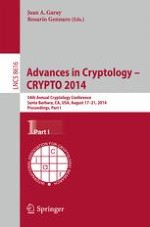2014 | OriginalPaper | Buchkapitel
The Exact PRF-Security of NMAC and HMAC
verfasst von : Peter Gaži, Krzysztof Pietrzak, Michal Rybár
Erschienen in: Advances in Cryptology – CRYPTO 2014
Verlag: Springer Berlin Heidelberg
Aktivieren Sie unsere intelligente Suche, um passende Fachinhalte oder Patente zu finden.
Wählen Sie Textabschnitte aus um mit Künstlicher Intelligenz passenden Patente zu finden. powered by
Markieren Sie Textabschnitte, um KI-gestützt weitere passende Inhalte zu finden. powered by
NMAC
is a mode of operation which turns a fixed input-length keyed hash function
f
into a variable input-length function. A practical single-key variant of
NMAC
called
HMAC
is a very popular and widely deployed message authentication code (MAC). Security proofs and attacks for
NMAC
can typically be lifted to
HMAC
.
NMAC
was introduced by Bellare, Canetti and Krawczyk [Crypto’96], who proved it to be a secure pseudorandom function (PRF), and thus also a MAC, assuming that (1)
f
is a PRF and (2) the function we get when cascading
f
is weakly collision-resistant. Unfortunately,
HMAC
is typically instantiated with cryptographic hash functions like MD5 or SHA-1 for which (2) has been found to be wrong. To restore the provable guarantees for
NMAC
, Bellare [Crypto’06] showed its security based solely on the assumption that
f
is a PRF, albeit via a non-uniform reduction.
Our first contribution is a simpler and uniform proof for this fact: If
f
is an
ε
-secure PRF (against
q
queries) and a
δ
-
non-adaptively
secure PRF (against
q
queries), then
NMAC
f
is an (
ε
+ ℓ
qδ
)-secure PRF against
q
queries of length at most ℓ blocks each.
We then show that this
ε
+ ℓ
qδ
bound is basically tight. For the most interesting case where ℓ
qδ
≥
ε
we prove this by constructing an
f
for which an attack with advantage ℓ
qδ
exists. This also violates the bound
O
(ł
ε
) on the PRF-security of
NMAC
recently claimed by Koblitz and Menezes.
Finally, we analyze the PRF-security of a modification of
NMAC
called
NI
[An and Bellare, Crypto’99] that differs mainly by using a compression function with an additional keying input. This avoids the constant rekeying on multi-block messages in
NMAC
and allows for a security proof starting by the standard switch from a PRF to a random function, followed by an information-theoretic analysis. We carry out such an analysis, obtaining a tight ł
q
2
/2
c
bound for this step, improving over the trivial bound of ł
2
q
2
/2
c
. The proof borrows combinatorial techniques originally developed for proving the security of CBC-MAC [Bellare et al., Crypto’05].
